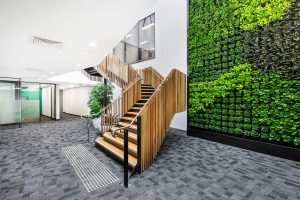Can arrows point to branding catastrophes?
Powerhouse Group design team
When your stunning office fit out is finally finished and ready to reveal, there are few better feelings than being wowed by the design as you’re shown around your new home away from home. It’s amazing!
The lead designer, account manager or maybe even one of the directors will casually point out an exquisitely crafted feature here or a miracle of ergonomics over there. Everything will flow as seamlessly as the descriptions that trip effortlessly from the lips of your tour guide. In the hands of a skilful office fit out orator, a showing of even the most labyrinthine call centres will seem as familiar to you as your own home. Access pads are punched as directions are reeled off, “there’s your office, second from the left, the bullpen, data centre entry beyond the second kitchen and breakout area, GM’s office is around this corner and past the fourth meeting room on your left. “Got it”, you affirm confidently as you match your guide stride for stride and smile for smile from ear to ear.
After the aroma of sparkling wine and incense has been spirited away by near noiseless extractor fans, you might want to place yourself in the shoes of the tour guide, just to ensure that all goes well on Monday at the big reveal.
Is this a bad sign?
The problem isn’t so much that you couldn’t find your way around. After all, you have the design docs and furthermore the signage is quite clear and conspicuous only… you wish it wasn’t. Why? Because the signs pointing the way to the amenities, the breakout rooms and/or the boardroom are jarringly out of step with your brand. How did you not see this before now? It’s not so much that that the corporate palette is wrong (it’s fine) but the choice of font, style, language and visual cues all miss the mark – significantly.
You didn’t notice it at the time because you were quite rightly concerned about the how the overall office fit out came together. Did they remember the additional baffling to afford senior management the privacy they would need? Yes. Is the kitchen all you could have hoped for your 105 co-workers? Check. Did the mural in the foyer complement the reception area’s central theme of modernity and warmth as requested? Yes, all of it is as you hoped as you gleefully followed your host from ornate pillar to cleverly positioned post, completely overlooking the slightly off-brand signage.
We see this a lot, but it doesn’t always register right away. The recognition of subpar signage usually manifests itself in the form of furrowed brows, double takes or, more commonly, a subconscious dissatisfaction with certain areas of the workplace even though, on the face of it, nothing at all seems wrong. These are all bad signs caused by “wayfinding” being treated as an afterthought, a footnote, a hastily cobbled together addendum as opposed to an opportunity to imbue every aspect of the workplace with your brand’s best attributes.
Why wayfinding warrants more work
Once you’ve inhabited a workplace for a certain period of time, and the duration varies from person to person, you know where everything is. You arrive at purpose-built projects rooms on time, you present yourself promptly to the boardroom, expertly navigating the high-end tech – you are a study in unconscious competence, as are your colleagues. You don’t need the wayfinding devices.
The problem is that those valued clients, engaged stakeholders and impressionable visitors tend to notice wayfinding because they need to. Whether they are waiting for a contact to emerge from behind the reception area to welcome them to the inner sanctum or trailing an HR assistant to an interview room, these things get noticed and make an impression – good, bad or indifferent.
Bad wayfinding or signage of any sort might include:
- Hastily prepared print outs fresh from the office printer displaying room names and arrows pointing the way
- Overly ornate, archaic or extravagant filigree dominating signage in a fastmoving, progressive tech hub
- Tech heavy solutions to directional challenges that merely require clear and concise instruction in keeping with a brand that spruiks simplicity
- A convoluted, hard-to-follow muddle of arrows and icons
- Staid and well-worn wayfinders that seem bloodless and dry against the conflicting office-based branding of an innovative hub or creative agency.
Remedial actions, particularly the necessary ones, are not always easy to execute. Far better to incorporate the solutions into the planning than to retrofit them. A solid return brief, will most certainly address wayfinding and the correct approach will also consider how best to assimilate the solutions with the brand. A certain consistency of theme is found across most office fit outs and the ones that prove to be a cut above the rest are also those that find a way to incorporate all functional requirements under the carefully conceived umbrella of branding.
That’s the way to do it.




